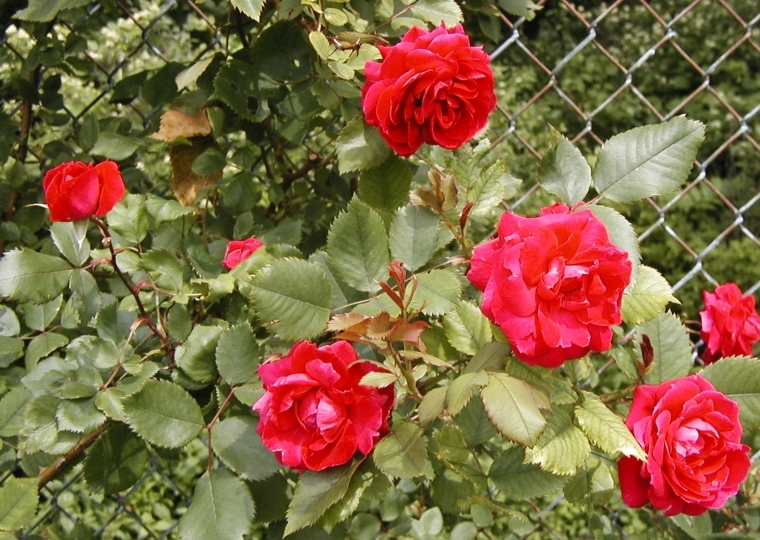Exercise 5.3: Colored Pencil: Rosa spp.
The rose is a woody perennial of the genus Rosa, within the family Rosaceae. Over 100 species are known to exist. The rose takes the form of a shrub, climber or can trail. A unique characteristic of roses are their sharp prickly stems. The flowers are large and showy, in colors ranging from white through yellows and reds. Most species are native to Asia, along with some native to Europe, North America, and Northwest Africa. Species, cultivars and hybrids are all widely grown for their beauty and fragrance.
Rosa spp. is an ideal subject to illustrate with colored pencils to show the wide variation of color and vibrancy; in addition, it is widely available and well-known throughout the world.
Now that we are getting toward the end of the class, we will focus on creating more finalized works of art. This assignment will be one of the most difficult, as we are working with detail and color. Similar to the last two assignments, we will create a finalized botanical illustration for Rosa spp. See below for the photos and description.
For this assignment please choose a specific rose to study and illustrate, which may vary greatly depending on your location in the world. Spend as much time as you need to complete this assignment. Remember your colored pencil techniques, along with all the details in the study.
As with the other assignments in this lesson, if there is a more suitable subject given your location, please elect to choose something different.
Submit when completed.
***
"The leaves are borne alternately on the stem. In most species they are 5 to 15 centimetres (2.0 to 5.9 in) long, pinnate, with (3–) 5–9 (–13) leaflets and basal stipules; the leaflets usually have a serrated margin, and often a few small prickles on the underside of the stem. Most roses are deciduous but a few (particularly from South east Asia) are evergreen or nearly so. The hybrid garden rose "Amber Flush" The flowers of most species have five petals, with the exception of Rosa sericea, which usually has only four. Each petal is divided into two distinct lobes and is usually white or pink, though in a few species yellow or red. Beneath the petals are five sepals (or in the case of some Rosa sericea, four). These may be long enough to be visible when viewed from above and appear as green points alternating with the rounded petals. There are multiple superior ovaries that develop into achenes.
Roses are insect-pollinated in nature. The aggregate fruit of the rose is a berry-like structure called a rose hip. Many of the domestic cultivars do not produce hips, as the flowers are so tightly petalled that they do not provide access for pollination. The hips of most species are red, but a few (e.g. Rosa pimpinellifolia) have dark purple to black hips. Each hip comprises an outer fleshy layer, the hypanthium, which contains 5–160 "seeds" (technically dry single-seeded fruits called achenes) embedded in a matrix of fine, but stiff, hairs. Rose hips of some species, especially the Dog Rose (Rosa canina) and Rugosa Rose (Rosa rugosa), are very rich in vitamin C, among the richest sources of any plant. The hips are eaten by fruit-eating birds such as thrushes and waxwings, which then disperse the seeds in their droppings. Some birds, particularly finches, also eat the seeds. Rose thorns are actually prickles - outgrowths of the epidermis. While the sharp objects along a rose stem are commonly called "thorns", they are technically prickles — outgrowths of the epidermis (the outer layer of tissue of the stem). (True thorns, as produced by e.g. Citrus or Pyracantha, are modified stems, which always originate at a node and which have nodes and internodes along the length of the thorn itself.) Rose prickles are typically sickle-shaped hooks, which aid the rose in hanging onto other vegetation when growing over it. Some species such as Rosa rugosa and Rosa pimpinellifolia have densely packed straight spines, probably an adaptation to reduce browsing by animals, but also possibly an adaptation to trap wind-blown sand and so reduce erosion and protect their roots (both of these species grow naturally on coastal sand dunes). Despite the presence of prickles, roses are frequently browsed by deer. A few species of roses have only vestigial prickles that have no points." Retrieved from "rose (plant) - Britannica Online Encyclopedia". Britannica.com. 2007-11-19. Retrieved 2009-12-07.



